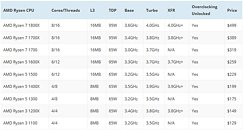- Joined
- Oct 9, 2007
- Messages
- 47,863 (7.38/day)
- Location
- Dublin, Ireland
| System Name | RBMK-1000 |
|---|---|
| Processor | AMD Ryzen 7 5700G |
| Motherboard | Gigabyte B550 AORUS Elite V2 |
| Cooling | DeepCool Gammax L240 V2 |
| Memory | 2x 16GB DDR4-3200 |
| Video Card(s) | Galax RTX 4070 Ti EX |
| Storage | Samsung 990 1TB |
| Display(s) | BenQ 1440p 60 Hz 27-inch |
| Case | Corsair Carbide 100R |
| Audio Device(s) | ASUS SupremeFX S1220A |
| Power Supply | Cooler Master MWE Gold 650W |
| Mouse | ASUS ROG Strix Impact |
| Keyboard | Gamdias Hermes E2 |
| Software | Windows 11 Pro |
AMD's upcoming Ryzen processors are "unlocked," in that they feature unlocked base-clock multipliers that let you easily overclock them; yet a few of its variants feature a brand extension "X." As our older article details, the "X" refers to availability of the XFR (extended frequency range) feature. Think of it as a second stage boost that rewards good CPU cooling with higher CPU clocks set automatically. The Ryzen R7-1800X, R7-1700X, R5-1600X, R5-1400X, and R3-1200X feature this.
The R7-1800X features clock speeds of 3.60 GHz, with TurboCore frequencies of 4.00 GHz and XFR ranging beyond 4.00 GHz. That of the R7-1700X is set beyond 3.80 GHz, and the R7-1600X beyond 3.70 GHz, R5-1400X beyond 3.90 GHz, and the R3-1200X beyond 3.80 GHz. There are no fixed values as to how much higher these frequencies will go, probably because AMD doesn't want to advertise clock speed figures consumers hold it to account for. The TurboCore frequencies, on the other hand, are achievable on even the included stock cooling solutions, or coolers that meet the TDP ratings of these chips.

View at TechPowerUp Main Site
The R7-1800X features clock speeds of 3.60 GHz, with TurboCore frequencies of 4.00 GHz and XFR ranging beyond 4.00 GHz. That of the R7-1700X is set beyond 3.80 GHz, and the R7-1600X beyond 3.70 GHz, R5-1400X beyond 3.90 GHz, and the R3-1200X beyond 3.80 GHz. There are no fixed values as to how much higher these frequencies will go, probably because AMD doesn't want to advertise clock speed figures consumers hold it to account for. The TurboCore frequencies, on the other hand, are achievable on even the included stock cooling solutions, or coolers that meet the TDP ratings of these chips.

View at TechPowerUp Main Site
Last edited:






 I'm building a HTPC and was hoping for something way lower than that, as you can get a i5 7500 using only 42W (65W TDP includes the iGPU).
I'm building a HTPC and was hoping for something way lower than that, as you can get a i5 7500 using only 42W (65W TDP includes the iGPU).


